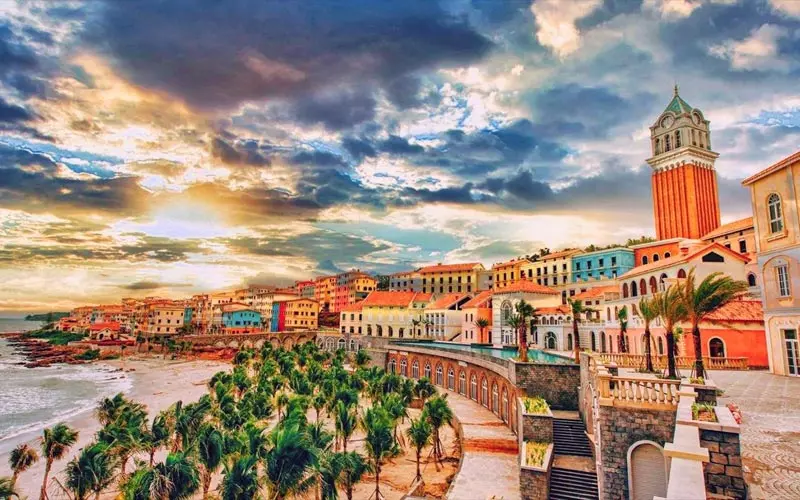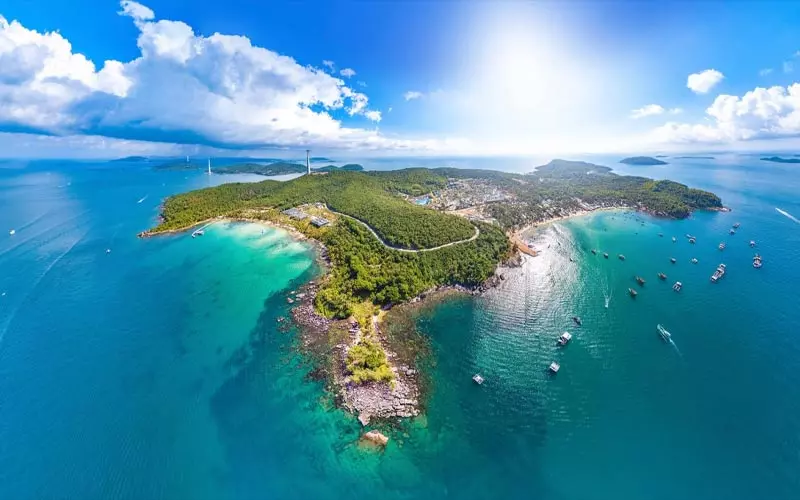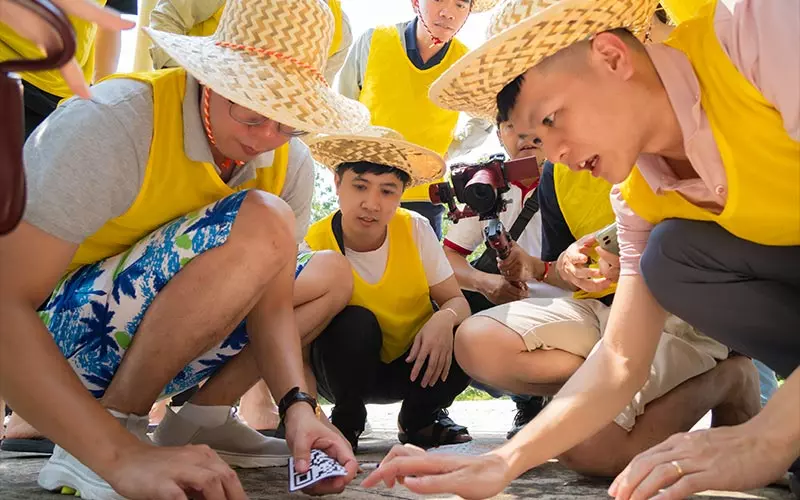Nestled on a rocky outcrop overlooking the sea, Dinh Cau Phu Quoc is more than a temple—it’s a symbol of the island’s soul. Built in 1937 with roots possibly stretching to the 17th century, this sacred site honors the guardian of fishermen and draws visitors with its blend of history, legends, and breathtaking views. From climbing its 29 steps to capturing sunsets by the lighthouse, a visit to Dinh Cau with Vina Phu Quoc Travel promises a deep dive into Phu Quoc’s spiritual and natural wonders.
Dinh Cau Phu Quoc: A Century-Old Spiritual Landmark
Introduction to Dinh Cau
Dinh Cau, also known as Long Wang Temple, is a cherished cultural and spiritual site in Phu Quoc, Vietnam. Perched on a rocky outcrop by the western shore, surrounded by the sea, rocks, and a lighthouse, this modest yet striking temple dates back to the 17th century, when early settlers arrived from central Vietnam. Built to honor Dinh Cau, the guardian deity of fishermen, it remains a symbol of protection and a top attraction for visitors seeking history and scenic beauty.

Located in Quarter 2, Duong Dong Ward, just 200 meters west of Phu Quoc’s town center, Dinh Cau faces the ocean at the mouth of the Duong Dong River. Its prime location and unique architecture make it a must-visit spot for photos and cultural exploration.
How to Get to Dinh Cau
Dinh Cau is a short walk or ride from central Duong Dong. Follow Tran Hung Dao Street, turn onto Vo Thi Sau, and head to the end, where you’ll find the Dinh Cau Night Market and the temple’s entrance. Climb 29 stone steps to reach the main courtyard, passing a small Tho Than shrine. The courtyard features a cement platform with an altar to Ong Thien and pillars inscribed with Chinese couplets:
“Vạn cổ anh linh thông tứ hải, Trấn phong bình lượng bảo lương dân”
(Translation: “For ages, sacred spirits echo across seas, Dinh Cau shields and protects the people.”)
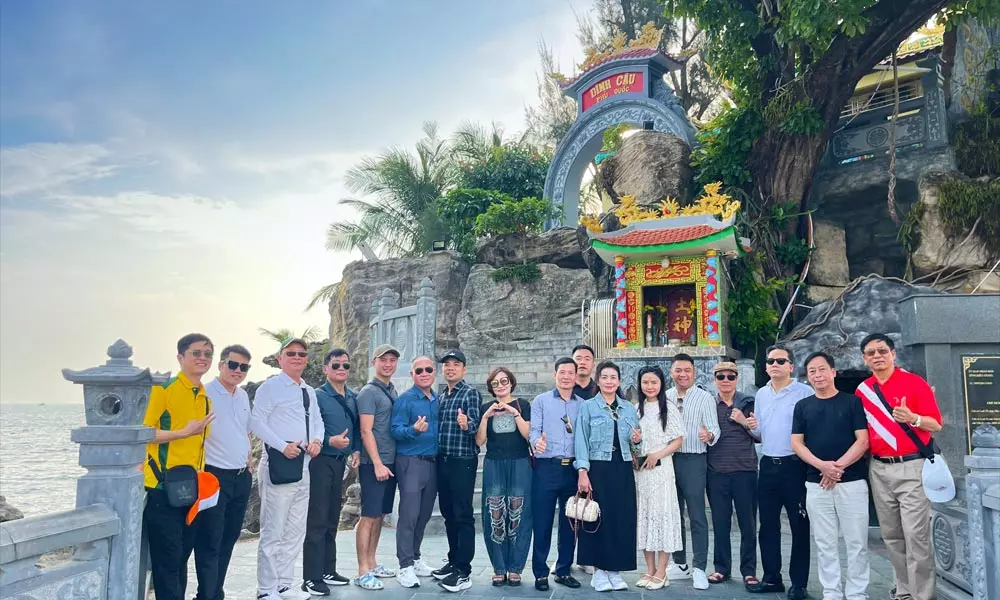
Architecture of Dinh Cau
Dinh Cau’s design blends northern Vietnamese temple aesthetics with local flair. Its red-tiled, curved roof resembles traditional pagodas, while the entrance, framed by a boat-shaped canopy and twin dragon motifs, reflects maritime heritage. The main gate, Thach Son Dien, bears inscriptions marking its construction in 1937, renovations in 1997, and recent updates in 2023. Though simple, the temple’s vivid colors and strategic seaside location give it a fortress-like presence, framed by rocks, sea, and the lighthouse.
Best Time to Visit Dinh Cau
The ideal time to explore Dinh Cau is from November to March or late April to June, when Phu Quoc enjoys cool, sunny weather with minimal rain. For a vibrant cultural experience, visit during the annual Dinh Cau Festival on the 15th and 16th of the 10th lunar month (typically October). This lively event features prayers for calm seas and prosperity, with free food offered to all visitors for three days, regardless of crowd size.
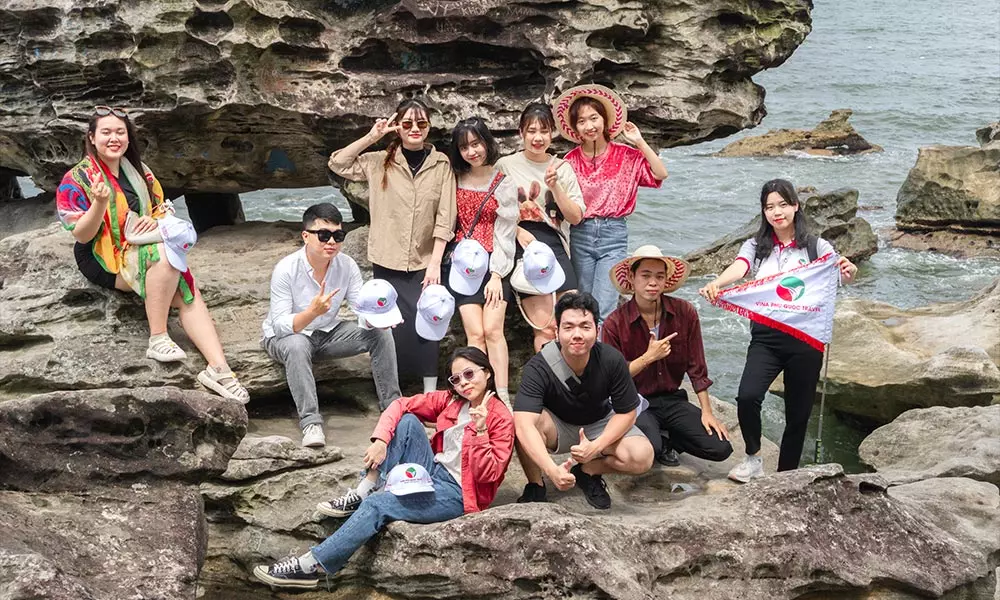
History of Dinh Cau
Established in 1937 and renovated in 1997 and 2023, Dinh Cau’s roots may trace back to the 17th century. Legend holds that when early fishermen faced deadly storms, a sacred rock emerged at the river’s mouth, guiding them to safety. Locals built a shrine to honor its protective spirit, naming it Dinh Cau. Over time, it became a beacon of hope for safe voyages.
Who Does Dinh Cau Worship?
Dinh Cau honors Cau Quy, Cau Tai, and Chua Ngoc Nuong Nuong, revered as protectors of fishermen and the island’s prosperity. This blend of Vietnamese, Cham, and Chinese spiritual traditions centers on the Mother Goddess cult, with the two “Cau” figures elevated alongside Chua Ngoc, reflecting the male-centric role of seafaring life. Fishermen still pray here before setting sail, believing Dinh Cau wards off storms.
Fascinating Legends of Dinh Cau
- Sacred Rock: In the 17th century, fishermen caught in storms spotted a rock rising from the sea, leading them to shore. Deemed divine, it became the foundation of Dinh Cau’s worship.
- Chua Ngoc and Her Sons: Locals believe Cau Tai and Cau Quy, sons of Chua Ngoc Nuong Nuong, were gamblers, attracting fortune-seekers to pray for luck.
- Mystic Monk: In the early 20th century, a silent monk tended the temple, later retreating to a cave beneath it for two years. He emerged as a seer, predicting futures during lunar festivals.
- Nguyen Anh’s Escape: In 1777, Nguyen Anh (later Emperor Gia Long), fleeing enemies, was stranded near Phu Quoc’s reefs. After praying to Chua Ngoc, a fisherman freed his ship, prompting him to honor her with a temple.
Highlights of Visiting Dinh Cau
- Photo Spots: Capture the 29 winding steps, quirky rock formations (including a turtle-shaped stone), or the historic lighthouse, built in the 1930s and now a national heritage site.
- Sunrise & Sunset: Watch dawn break or the sky turn orange over the Gulf of Thailand—perfect for romantic or serene moments.
- Spiritual Visits: Pray for peace and prosperity, especially on the 1st and 15th lunar days, when locals and tourists flock here.
- Ancient Tree: Relax under a centuries-old sop tree, soaking in cool sea breezes.
- Beach Time: Swim at Dinh Cau Beach, part of Bai Dai, or join night squid fishing tours.
Nearby Attractions
- Dinh Ba Phu Quoc: A temple honoring Thuy Long Thanh Mau (Kim Giao) at 44 Vo Thi Sau, a short walk away.
- Phu Quoc Night Market: A food and shopping hub with local snacks and souvenirs.
- Duong Dong Market: A bustling spot for fresh seafood and gifts.
- Bach Dang Park: A colorful spot for evening strolls, just two minutes from Dinh Cau.
- Ham Ninh Fishing Village: A glimpse into traditional island life, a short drive away.
Getting to Dinh Cau
- Taxi/Car: Affordable for groups, costing 12,000–20,000 VND per km. Book trusted services like Vina Phu Quoc Travel’s rentals.
- Motorbike: Rent for 180,000–200,000 VND daily to explore scenic routes at your pace.
FAQs About Visiting Dinh Cau
- Hours & Fees: Open daily from 7:00 AM to 8:30 PM, free entry.
- Best Time: November to June for pleasant weather; October for the festival.
- Festival Details: Held on the 15th–16th of the 10th lunar month with ceremonies and lively activities.
- Local Specialties: Buy banh kheo, banh bo thot not, or dried seafood at nearby markets—choose reputable vendors.
Tips for Visitors
- Dress Code: Wear modest clothing to respect the sacred site.
- Photography: No photos inside the main hall; ask permission for filming.
- Cleanliness: Dispose of trash properly to preserve the site’s beauty.
Discover Dinh Cau’s timeless charm with Vina Phu Quoc Travel’s tailored tours or travel guides. Book now for an enriching Phu Quoc adventure!




